#delaware and hudson railroad
Text

149 notes
·
View notes
Text

MNCR 5043, Katonah, NY, 1983
Metro-North's early days were not easy, A southbound Harlem Line train approaches Katonah the morning after a blizzard dumped more than two feet on the area on February 13, 1983. A former New Haven FL9 leads a set of coaches originally rebuilt for Delaware & Hudson/Amtrak Adirondack service.
Art Deeks photo
#commuter train#mncr#metro north commuter railroad#mta#metropolitan transportation authority#d&h#delaware & hudson#1983#new york city#trains#passenger train#history#katonah#new york
28 notes
·
View notes
Text
Take a Walk 09/22/24 - Albany, NY Special Edition
Just a note to the 3 day-one fans/followers of my take a walk commentary series, I have a few posts to catch up on that are dated and slated to be put together as soon as I find the time. But I just wanted to get this special edition out as soon as I could because its fresh and I have the motivation to and this one is short. (And because this is my blog, and I make the rules, and were doing this one first!!)
While I was visiting my friends in Albany, a place I called home for a number of years, I had some time to kill so my old friend and I decided to take a long walk and shoot some photos. :)

First off we have the Hinckel Brewery building originally built as just the right-most building in 1855, with additions made in subsequent years as the business began to grow to be one of the biggest beer distributors in the Northeast even rivaling Anheuser-Busch and Samuel Adams during the early 1900's.
The original architect is unknown, but to the best of my understanding many of the building's interiors as well as the surrounding building complex have been modernized and incorporated into the @HudsonPark apartment scheme. I wasn't able to find a lot of info on the apartments that exist therein within the apartment complex, and they don't exactly have rave reviews on sites like google and apartments.com.
When we walked into the small inner concrete courtyard underneath the old docking bay in the office building, the vibe was very vacant aside from being locked and then this strange noise I caught of one of the seemingly-annoyed tenants who wasn't happy we were all up in their business. (either that or it was a ghost, give the sound a listen in the last 5 seconds of this video and let me know lol).
-
Then we walked past some of my favorites, that I neglected to get pictures of -_- bc I didn't think I would be making this post, BUT that I'll def be able to get pictures of from my archives/google. I'll throw together a short run through of those real quick and then get to the main event.
-


The Van Ostrande-Radliff House at 48 Hudson Ave, a must see (even if you cant see much) in Albany. This is the oldest standing building in the city, originally built in 1728. Preservation efforts are ongoing to restore it to its former charm, but it remains covered for the time being so as to not fall into further disrepair. I recommend checking out the sick pictures that Historic Albany Foundation has on their website of the current interior.
-




Down the street is the SUNY Headquarters Building, an old railroad building that served the state capitol under the Delaware & Hudson Railroad Co. Architect Marcus T. Reynolds designed this one, it was originally built as six separate buildings from 1915 on and connected to form one continuous structure, this imposingly beautiful Flemish Gothic building is one of my personal favorites in downtown Albany.
-

Turning around we see this beautifully ornate neo-classical building at the corner of State St. & Broadway. Originally built as the Albany Trust Company building in 1902, also by architect Marcus T. Reynolds! This building has such a striking facade and the renaissance revival dome is truly an architectural masterpiece (if not bordering on a little gaudy). I was so lucky to find out they had just given it a fresh spruced up paint job when I walked by it! Today it operates as the SUNY Research Foundation building.
-


Then juuuust up the street 2 buildings away is BY FAR my favorite little guy in the city (I would treat her so right, please god give me a chance).
This is 63 State St. Being built originally by one of my favorite architects, Russell Sturgis in 1876 for the Mechanics & Farmers Bank. For such a small sliver of a property footprint this building just does so much right with its balance of form and ornament. The turret on the corner is stunningly delicate, as well as the bright red brick to complement the light sandy stone. Not to mention that beautifully ornate third floor circle window. This building changed hands a couple times throughout the centuries but retains the old vault door in the basement as well as the brass fixtures and marble floorings inside that give it quite the stately presence upon entering.
-

How could I not include the most imposingly large, ornate, stately, balanced (every other adjective I've ever used on this blog...) building in Albany, the state capitol building!? Main architect: Henry Hobson Richardson, along with Leopold Eidlitz, Thomas Fuller, and Isaac G. Perry. Finished in 1899 after 32 years!
I'm going to keep this very brief because we only stopped here briefly on our walk and this building deserves it's own deep dive post at some point anyway. Plus it isn't even the aforementioned "Main Event" of our walk. But the detail in the scrolling on the columns here is absolutely insane. My friend and I were discussing it's architectural style/influences and we weren't completely convinced it falls into any one, Italianate/Neoclassical/Victorian/Georgian/Flemish/Gothic/Spanish influences... the confluence of styles in this design is absolutely masterful. As well as whether one would consider the columns corinthian or not, maybe composite? But just take a look at these bad boys, I would sit and take a full semester's course just on the symbolism sprinkled in and throughout this structure.

The scrolling is unique on EVERY column and sprinkled with tons of historical imagery and symbolism but they all have the same visual weight and if you weren't paying attention you'd never notice.
-





If you think nothing could compete with the capital building's insanely intricate detail look across the street for it's closest competitor, The State Education Department building and Chancellor Hall at 89 Washington Ave. I think I remember thinking for a long time this was my favorite Albany building for years before discovering the charming old gothic bank building on lower State St.
Spanning a whole city block (a long one) is this building's imposing Greek-revival corinthian colonnade with 36 massive columns along it! Another scale-defying building joining the capitol building at you-have-to-see-it-in-person scale, the columns on this bad boy are comparable to the width of a redwood tree (see the picture of my legs as I lay down between them to get shots of the ceiling).
Originally Built in 1911 by architect Henry Hornbostel, this building has retained it's integrity and intention by functioning as the base of operations for the NY state education system since its completion. Its structure and facade, including the intricate brass lighting fixtures and the beautiful tiling along its exterior, has been kept in immaculate condition and is incredible to look at in person. This is another architectural feat with such minute detailing that I could sit there with an expert for probably weeks just in awe of it's symbols and attention to detail. I sat there for about 20 minutes when we visited it just looking at it and taking its beauty in. This is the type of building that just transports you somewhere else when you really take it in, it could've easily been cherry picked from the acropolis and plopped in upstate New York and you wouldn't question it thats how beautifully true to form it feels in person.
I didn't know I would be making this post in the moment while taking the walk so I don't have a dishonorable mention, but if you've ever been to Albany, NY you know there are far too many of those to ever pick from so I'm going to give myself a pass this time.
#albany ny#architect#architecture#cast iron#greek revival#romanesque#column#italianate#mansard roof#art#Hinckel Brewery#@hudsonpark#Marcus T. Reynolds#Henry Hornbostel#russell sturgis#Van Ostrande-Radliff#Van ostrande-radliff house#Jared Holt#Historic Albany Foundation#SUNY Headquarters#SUNY#NYS Education Department#neoclassical#Albany Trust Company#Mechanics & Farmers Bank#D&H#Delaware & Hudson#Delaware & Hudson Railroad Co.#Flemish Gothic#Gothic
0 notes
Text
Port Jervis, New York - A Historic Canal and Railroad Transport Hub

With roots as a pre-automobile transportation hub, Port Jervis, New York, is a historic burgh with a history of colonial settlement extending to the 1690s. Northeast of New York City, it’s situated amidst the fertile valleys of the Delaware and Neversink River systems. The valleys mark the boundary between the Appalachian Plateau and Shawangunk Mountains, and hundreds of miles of state and nationally-managed recreational lands surround it.
Initially known as Carpenter’s Point, Port Jervis was a landing point for timber raftsmen who plied the upper Delaware River. It was also a stop on the Old Mine Road, the country’s first 100-mile road (now United States Route 209), which took travelers south from Kingston.
Carpenter’s Point was incorporated into Deerpark in 1798. The locale was named Port Jervis in 1827, and it officially became a port of the Delaware River and Hudson Canal in 1828. As a repair point and boat basin, it formed an essential station on a 171-mile-long transportation network that brought anthracite coal from Pennsylvania’s northeastern mountains to New England and New York City. The name was in honor of the Hudson Canal’s chief engineer, John B. Jervis, from Rome, New York.
In 1847, Port Jervis became a hub for railroad operations and grew to house a main engine terminal facility while serving as the Delaware Division of the Erie Railroad’s headquarters. This property included the railroad’s primary maintenance and yard facilities.
Port Jervis officially became a village in 1853 and ultimately incorporated as a city in 1907. In the late 19th century, several glass factories began business, and an influx of employees producing glassware, silk, gloves, shorts, mittens, and saws moved in. The railroad yards and light manufacturing shops were a major part of the local economy through the 1960s.
Today, tourism is the mainstay of Port Jervis, with historic Front Street featuring eateries, a bookshop, antique shops, and other small businesses. The well-marked Delaware River Heritage Trail provides a walking tour of various gardens, historical structures, and an exceptional view of the Delaware River.
Among the well-preserved sites worth exploring is Fort Decker, a stone house on West Main Street that was initially constructed in 1760 and burnt by Joseph Brant alongside Native American allies in a 1779 raid during the Revolutionary War. Serving as the Minisink Valley Historical Society museum, Martinus Decker rebuilt the house in 1793 and used it as a tavern and hotel during the years of the Delaware and Hudson Canal construction. Indeed, John B. Jervis stayed at the location while engineering the canal.
Another historic remnant is the Port Jervis turntable, which comprises a circular area with a 115-foot diameter and a bridge. Able to carry a weight of more than 440 tons or a locomotive loaded with coal and water, the turntable is the largest that still operates nationwide.
Befitting its status as a scenic tourist destination, Port Jervis offers several popular events each year, including the Fall Foliage Festival, for which volunteers place 50 corn stalks on light poles decorating Pike and Front Streets. There are also popular holiday events such as the Downtown Spooktacular and the Chriskindlmarkt, with the latter featuring horse and carriage rides and traditional juggling as entertainment.
3 notes
·
View notes
Note
Hey, Max.
In my alternate history of the railroads, “What-If: American Railroads”, New York Central absorbed the Boston & Maine, New Haven Railroad, Delaware & Hudson, Rutland Railroad, Bangor & Aroostook Railroad, Central Vermont, and Maine Central Railroad.

Max: wow
5 notes
·
View notes
Text
What-If: American Railroads — Section 2: Railroads Absorbed (part 1)
With my alternate history on American railroads, one major part of it is that President Dwight D. Eisenhower would pass a Staggers Act of 1955, which would allow railroads to innovate and expand their operations and provide healthy competition with not only other railroads, but also cars and planes. While the big railroads (like New York Central and Chesapeake & Ohio) would greatly benefit from this, the smaller railroads (like New Haven or Western Pacific) wouldn’t be as lucky… but the smaller railroads’ territories would not go to waste as from the late 1950s to the early 1970s, the bigger railroads would absorb the smaller ones. And the smaller railroads absorbed by the bigger ones will be shown below with the big railroads’ logos being above a collection of maps of the smaller railroads.



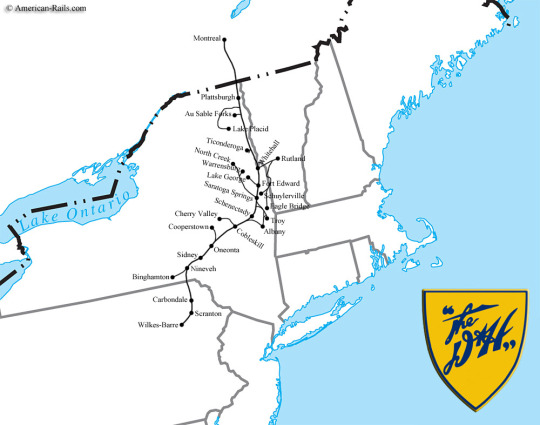
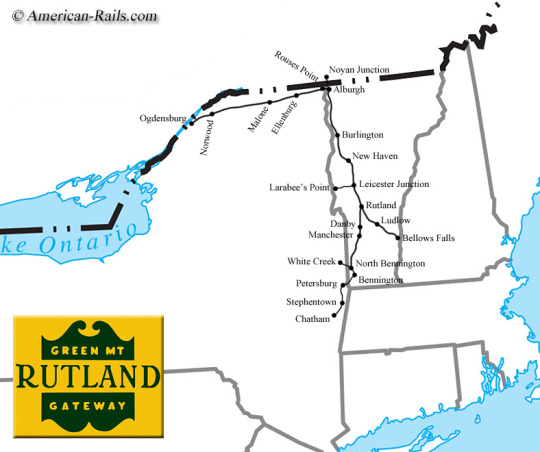



A. New York Central ⬆️.
Boston and Maine
New Haven
Delaware and Hudson
Rutland Railroad
Bangor and Aroostook Railroad
Central Vermont
Maine Central


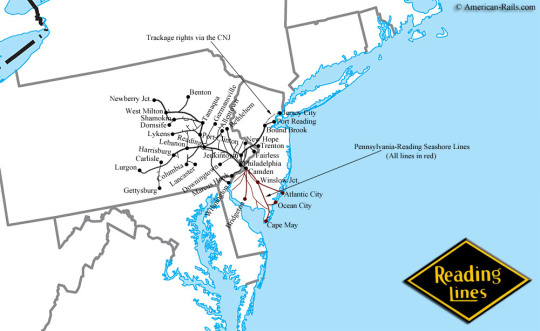
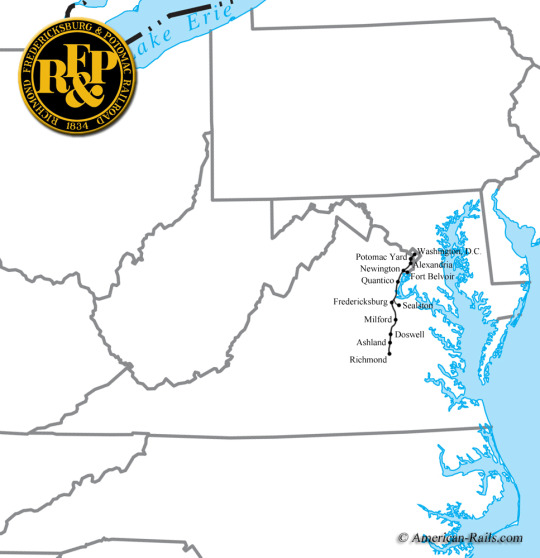
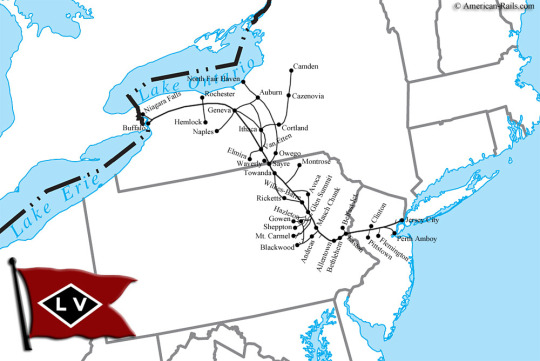
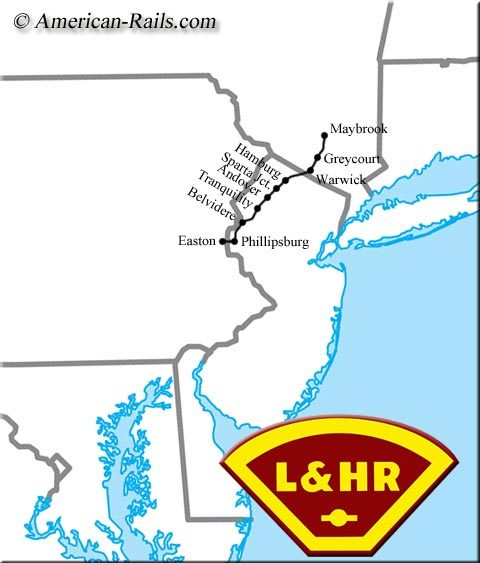

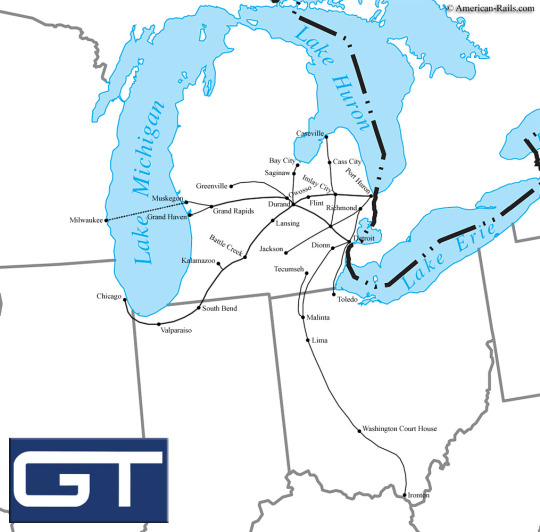

B. Pennsylvania Railroad ⬆️
Lehigh New England
Reading Lines/Railroad
Richmond, Fredericksburg and Potomac
Lehigh Valley
Lehigh and Hudson River
Central Railroad of New Jersey
Grand Trunk Western
Pennsylvania-Reading Seashore Lines



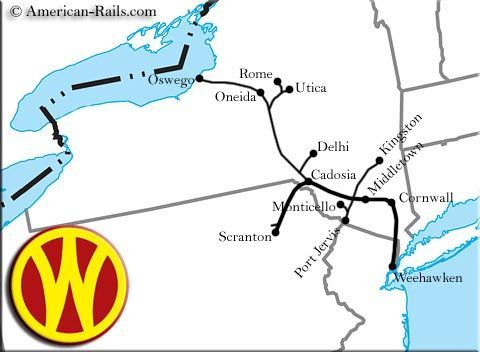
C. Chesapeake and Ohio ⬆️
Erie Railroad
Lackawanna Railroad
New York, Ontario and Western Railway

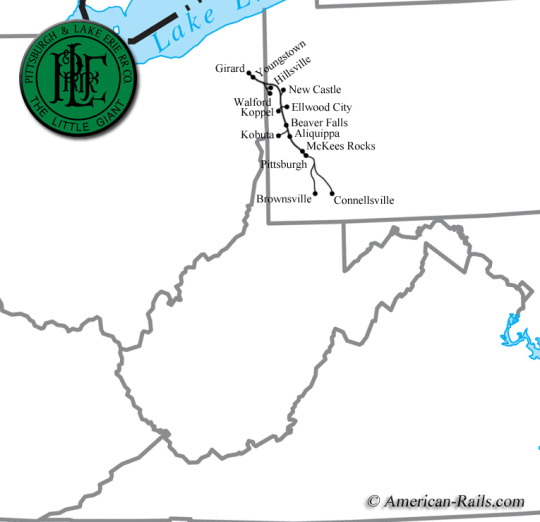
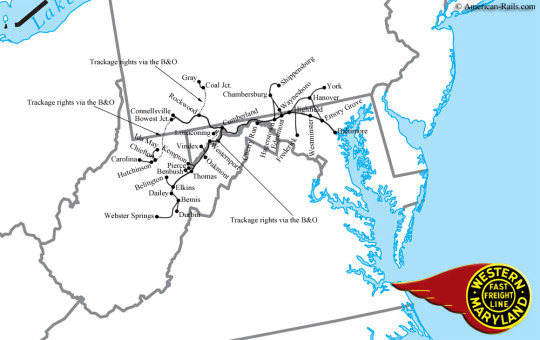


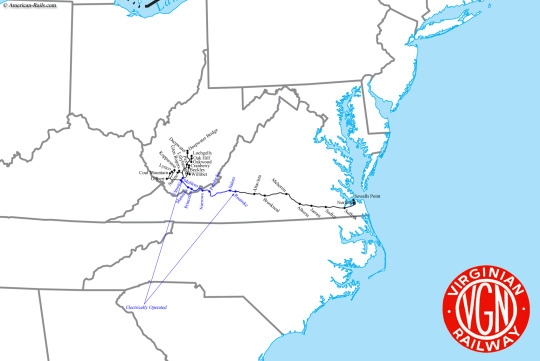
D. Baltimore and Ohio ⬆️
Pittsburgh and Lake Erie
Western Maryland
Wabash
Ann Arbor
Virginian Railway
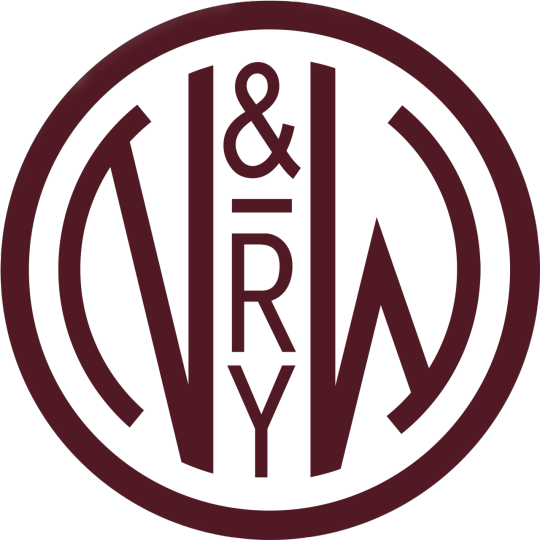


E. Norfolk and Western ⬆️
Nickel Plate Road
(original) Norfolk Southern
#history#railroad#railroads#railway#railways#new york central#pennsylvania railroad#chesapeake & ohio#baltimore & ohio#norfolk and western#alternate history
2 notes
·
View notes
Video
Upstate Alcos por David Blazejewski
Por Flickr:
I can't wait to someday see this beauty running on home rails but until then here is another roster shot of David Coppola's then recently painted and absolutely stunning SNEX 5015. She is an Alco RS36 blt. Jan. 1963 for the Delaware and Hudson Railway with this number. 5015 is dressed in a facsimile of an experimental one of a kind scheme that it wore in the early 1970s on the D&H. To see it in that scheme and several other paint jobs it wore in its past check out the old shots here: rrpicturearchives.net/LocoPicture.aspx?id=11531 And if you're looking for power for your shortline or industrial operation this locomotive is available for lease. Check out this page where you can contact the owner for more info here: www.snerr.us/equipment The colorful unit visible in the background is BKRR 605, an Alco RS3 blt. Nov. 1950 as Lehigh and Hudson River 10. She was sold 5 years before that little road disappeared into Conrail becoming St. Johnsbury and Lamoille County 205. After another 5 or 6 years she migrated over to the Vermont Railway renumbered 605 and dressed in red paint. After another eight or so years in Vermont she left for the newly created Batten Kill and was done up in this handsome scheme. Here she sits tucked up at the end of track on the Carovail Spur just west of the Cargill elevator near MP 8.5 on the original Greenwich and Johnsonville Railroad as measured from Greenwich. The main track here behind me dates from after 1906 when the Delaware and Hudson (which had acquired the little shortline that year) built this approximately 10 mile line east to connect with it's Washington Branch route at Greenwich Jct. For it's entire life until being sold to the new Batten Kill it was an independent and wholly owned subsidiary of the D&H. Salem, New York Monday October 17, 2022
3 notes
·
View notes
Text
Events 8.28 (before 1920)
475 – The Roman general Orestes forces western Roman Emperor Julius Nepos to flee his capital city, Ravenna.
489 – Theodoric, king of the Ostrogoths, defeats Odoacer at the Battle of Isonzo, forcing his way into Italy.
632 – Fatimah, daughter of the Islamic prophet Muhammad, dies, with her cause of death being a controversial topic among the Sunni Muslims and Shia Muslims.
663 – Silla–Tang armies crush the Baekje restoration attempt and force Yamato Japan to withdraw from Korea in the Battle of Baekgang.
1189 – Third Crusade: The Crusaders begin the Siege of Acre under Guy of Lusignan.
1521 – Ottoman wars in Europe: The Ottoman Turks occupy Belgrade.
1524 – The Kaqchikel Maya rebel against their former Spanish allies during the Spanish conquest of Guatemala.
1542 – Turkish–Portuguese War: Battle of Wofla: The Portuguese are scattered, their leader Christovão da Gama is captured and later executed.
1565 – Pedro Menéndez de Avilés sights land near St. Augustine, Florida and founds the oldest continuously occupied European-established city in the continental United States.
1609 – Henry Hudson discovers Delaware Bay.
1619 – Election of Ferdinand II, Holy Roman Emperor.
1640 – Second Bishop's War: King Charles I's English army loses to a Scottish Covenanter force at the Battle of Newburn.
1648 – Second English Civil War: The Siege of Colchester ends when Royalists Forces surrender to the Parliamentary Forces after eleven weeks, during the Second English Civil War.
1709 – Meidingnu Pamheiba is crowned King of Manipur.
1789 – William Herschel discovers a new moon of Saturn: Enceladus.
1810 – Napoleonic Wars: The French Navy accepts the surrender of a British Royal Navy fleet at the Battle of Grand Port.
1830 – The Baltimore and Ohio Railroad's new Tom Thumb steam locomotive races a horse-drawn car, presaging steam's role in U.S. railroads.
1833 – The Slavery Abolition Act 1833 receives royal assent, making the purchase or ownership of slaves illegal in the British Empire with exceptions.
1845 – The first issue of Scientific American magazine is published.
1849 – Revolutions of 1848 in the Austrian Empire: After a month-long siege, Venice, which had declared itself independent as the Republic of San Marco, surrenders to Austria.
1850 – Richard Wagner’s Lohengrin premieres at the Staatskapelle Weimar.
1859 – The Carrington event is the strongest geomagnetic storm on record to strike the Earth. Electrical telegraph service is widely disrupted.
1861 – American Civil War: Union forces attack Cape Hatteras, North Carolina in the Battle of Hatteras Inlet Batteries which lasts for two days.
1862 – American Civil War: The Second Battle of Bull Run, also known as the Battle of Second Manassas, begins in Virginia. The battle ends on August 30 with another Union defeat.
1867 – The United States takes possession of the (at this point unoccupied) Midway Atoll.
1879 – Anglo-Zulu War: Cetshwayo, last king of the Zulus, is captured by the British.
1898 – Caleb Bradham's beverage "Brad's Drink" is renamed "Pepsi-Cola".
1901 – Silliman University is founded in the Philippines. It is the first American private school in the country.
1909 – A group of mid-level Greek Army officers launches the Goudi coup, seeking wide-ranging reforms.
1913 – Queen Wilhelmina opens the Peace Palace in The Hague.
1914 – World War I: The Royal Navy defeats the German fleet in the Battle of Heligoland Bight.
1916 – World War I: Germany declares war on Romania.
1916 – World War I: Italy declares war on Germany.
1917 – Ten suffragists, members of the Silent Sentinels, are arrested while picketing the White House in favor of women's suffrage in the United States.
0 notes
Text
transit idea
okay so it's a well-worn idea that transit in the united states is perpetually strapped for cash. this seems to be especially true on the east coast, where old, well-established systems are falling apart and running on fumes
so i have an idea to help some of these agencies - specifically, the ones surrounding new jersey - out of their cash deficits. and that is:
carve up nj transit and merge the pieces with other agencies
more specifically:
the northern half of njtransit
(including busses and light rails in bergen, hudson, essex, union, somerset, middlesex, monmouth, passaic, morris, sussex, hunterdon, and warren counties; all commuter rail lines terminating at newark, new york, or hoboken; and the princeton dinky)
would be merged with the MTA
(which runs the new york subway and busses, metro-north, and the long island railroad)
and the port authority of new york and new jersey
(which runs PATH trains, and owns newark airport, laguardia, jfk, every major bridge and tunnel connecting new york and new jersey, and a lot of the bridges and tunnels between boroughs, and the ports of new york and new jersey)
the southwestern part of njtransit
(including bus services in mercer, burlington, camden, gloucester, salem, and cumberland counties; all njtransit busses servicing philadelphia, camden, or trenton; plus the RIVER Line and the atlantic city line)
would be merged with SEPTA
(which runs the philadelphia subway, busses, and commuter rails)
and the delaware river port authority
(which runs PATCO trains, every bridge between new jersey and pennsylvania south of and including the betsy ross bridge, and all of the ports of the philadelphia areas)
the coastal part of nj transit
(including all busses servicing ocean, atlantic, and cape may counties; and all busses terminating at lakewood)
would be merged with the new jersey turnpike authority
(which manages the atlantic city expressway, the garden state parkway, and the new jersey turnpike)
there are a lot of advantages to this idea, so i'm gonna run through them:
advantages
operating trains over state lines would become a lot easier when the trains are operated by multi-state agencies like the port authorities
because the airports and transit would no longer be operated by different agencies, we would get free transfers from jamaica to JFK, howard beach to jfk, and newark airport station to newark airport - each of which currently cost 8 dollars in either direction
free transfers between PATCO and SEPTA trains would significantly simplify 8th street station, and a unified fare control would finally give SEPTA the impetus to reopen the tunnel between walnut-locust station and the PATCO stations at 15th/16th and at 12th/13th
this could enable free transfers between PATCO and the RIVER Line, and between PATH and the newark light rail, hudson-bergen line, and the new york subway - giving you a one-fare ride from anywhere in new york city to anywhere in newark or jersey city
for coastal jersey, this could encourage express busses that run on the garden state parkway, which could reduce traffic on the notoriously congested road (same with the atlantic city expressway)
capitol projects interconnecting regions that are separated by state lines would become much easier when they are operated by interstate agencies
lastly, many of these agencies which make a humongous amount of money off of car tolls (and are often overflowing with money) would suddenly be forced to share their profits with the horribly indebted transit agencies. this would give a lot more money to the transit agencies, and enable them to finally invest in capitol projects instead of constantly being forced to scrounge just to stay operational
what do you guys think? why is this a bad idea? why is this a good idea? i genuinely wanna hear what other people think of this, because i think it's a decent idea
#new york#new jersey#philadelphia#nj transit#mta#septa#panynj#transit#mass transit#public transit#usa#new york subway#urbanism
0 notes
Link
Check out this listing I just added to my Poshmark closet: Postcard Delaware and Hudson Railroad Locomotive 653 Century of Progress Exposit.
0 notes
Text

Delaware and Hudson Railroad station
Saratoga Springs, New York, circa 1900
source
4 notes
·
View notes
Photo
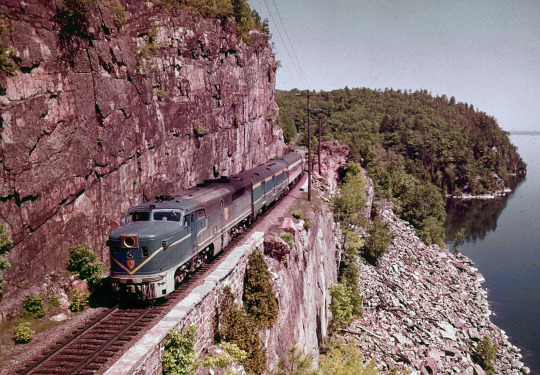
242 notes
·
View notes
Text

First car is former D&H diner.
Chappaqua, NY
April 27, 1982
#commuter train#cr#conrail#mta#metropolitan transportation authority#pc#penn central#nynh&h#new haven railroad#d&h#delaware & hudson#1982#new york city#trains#passenger train#history#chappaqua#new york#dining car#diner
14 notes
·
View notes
Text
Route Review: Rail Explorers Catskill Division
Launched in 2018, the Rail Explorers Catskill Division River Run starts at the old train station in Phoenicia, NY and runs on track of the former Ulster and Delaware Railroad along the Esopus Creek. Since the Catskill Mountain Railroad ceased tourist operations on this scenic stretch of track in 2016, Rail Explorers has brought new life--and maintenance--to this historic line. I pedalled this route in July of 2018 and some details have changed as described below. Operations are closed for the winter, but will resume on May 18th and bookings are already being taken.
The Site
Nestled in the eastern Catskills, the start of the route is in the yard of the former Phoenicia Train Station, which is listed in the National Register of Historic Places and houses the Empire State Railway Museum. The yard and sheds are home to a collection of locomotives, coaches and cabooses. Until their lease with Ulster County expired in 2016, the Catskill Mountain Railroad used the station and equipment for tourist rides along the same alignment.
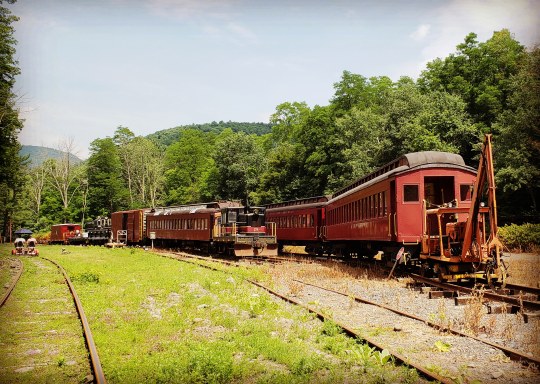
The Route
Running along the Esopus Creek, the River Run is a leisurely 8-mile (12.9 km) round trip beside campgrounds and country homes. At one point, the tracks cross Route 28 and the riders are treated to protection from traffic with crossing gates and signals originally installed for the railroad.
At the turnaround, riders wait in a seating area while the railbikes are turned around using on-track turntables (shown here in former routes in the Brandywine Valley, Delaware and Saranac Lake, NY).
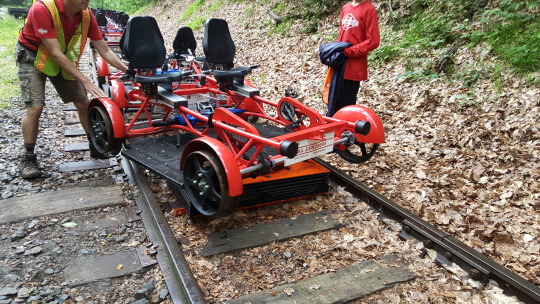
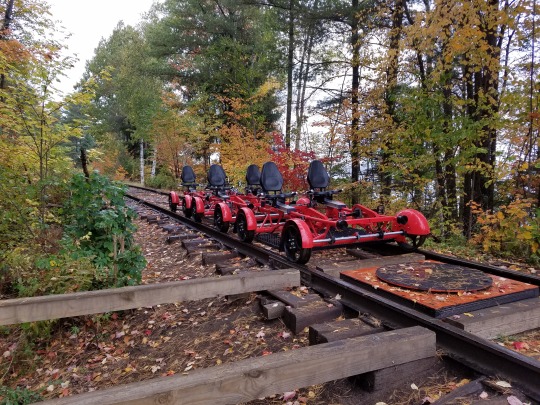
Given that the Esopus Creek feeds the Ashokan Reservoir, a major element of the NYC water supply, there are strict environmental standards in place along the route. Always innovators, Rail Explorers founders Mary Joy and Alex Catchpoole devised a way to keep the tracks clear of overgrowth without using polluting chemicals. Here is their trailer-mounted mower, which can be towed behind a rail bike.
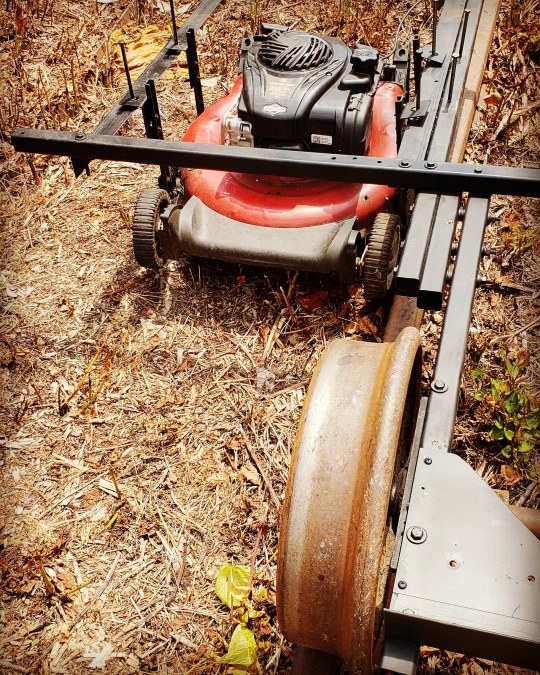
The 4 miles (6.4 km) used by Rail Explorers are part of 38 miles (61 km) of line owned by Ulster County, which is part of the greater line that formerly ran from Kingston Point on the Hudson River to Oneonta, NY where it met the Delaware and Hudson Railroad. Originally envisioned as a summertime-only connection to resorts in the Catskill Mountains, it eventually ran year-round carrying both passengers and freight and served branch lines to Hunter and Kaaterskill. The second half of the 20th Century saw the demise of the line, with mail and passenger service ending in 1954 and freight service ending in 1976.
The 2.4 miles (3.9 km) from Kingston Point to the Rondout neighborhood of Kingston, NY are now used by the Trolley Museum of New York. The section from Kingston to Hurley is used for tourist train excursions by the Catskill Mountain Railroad. Beyond Ulster County, the Delaware and Ulster Railroad run tourist trains around Arkville, NY.
Closer to Phoenicia, many bridges and creekside tracks have been washed away by storms and flooding since the closure of the railroad, isolating the section from other operations. Furthermore, exposed to similar spacial politics of several routes described in this blog, the future of the line is in question and subject to a legal battle over the use of the right-of-way, with Ulster County planning to remove much of the track to create a recreational trail. The section in use by Rail Explorers appears to be safe from this plan, although the future of the tourist trains remains unclear.
The Vehicles
I pedalled this route aboard the steel-framed, cast-iron-wheeled railbikes described in my earlier post on the Rail Explorers Las Vegas Division. However, as noted on the Rail Explorers website, they offer a “new Rail Explorers fleet of rail bikes, now with electric pedal assistance!” I look forward to returning to Phoenicia this year to see the new railbikes. Here is a great shot of a tandem from Saranac Lake on Rail Explorers Instagram account.
View this post on Instagram
A post shared by Rail Explorers USA (@railexplorersusa) on Feb 14, 2019 at 8:19am PST
Travel Notes
While Phoenicia is typically reached by car, Trailways offers daily buses from New York City through New Paltz, Kingston and on to Oneonta. It is a short walk from the center of the hamlet to the starting point at the station. The completion of the Empire State Trail in connection with the recreational trail planned by Ulster County might offer options for reaching Phoenicia by bicycle in the future.
Phoenicia is a popular tourist destination, perhaps best known for whitewater tubing along the Esopus Creek, and centrally located near many options for hiking, skiing and fly-fishing. Nearby Belleayre Ski Resort offers summertime gondola rides for hiking, mountain biking and sightseeing. Main Street in Phoenicia has a small stretch of shops, pizzerias, bars and restaurants. The nightlife in nearby Woodstock has picked back up in recent years, especially thanks to the Station Bar and Curio, where one can enjoy drinks and live music in a station that used to serve the same line described above.
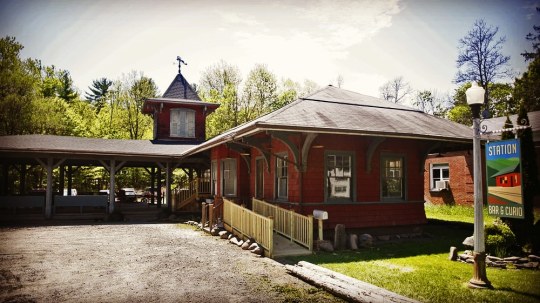
#railbike#railbikes#railbiking#railexplorers#phoenicia#phoeniciany#catskills#catskill mountains#empire state railway museum#catskill mountain railroad#delaware and hudson railroad#trolley museum of new york#esopus creek#belleayre#kingston new york#woodstock#pinehill#arkville#station bar and curio
4 notes
·
View notes
Photo

A Delaware & Hudson passenger train heads toward Binghamton through Afton, New York in April 1974. The highway in the foreground is New York Route 7. Photo by R.E.Allison.
27 notes
·
View notes
Photo

A Challenger leads a southbound freight with a new Pennsylvania RR Alco switcher in delivery just behind the tender.
Schenectady, NY
1948
#d&h#delaware & hudson#prr#pennsylvania railroad#1948#trains#freight train#history#schenectady#new york
15 notes
·
View notes